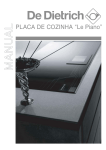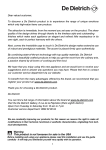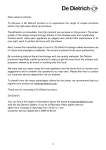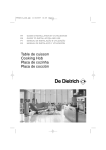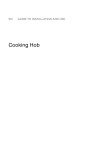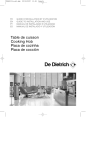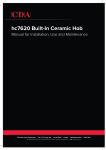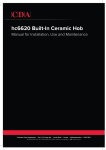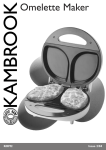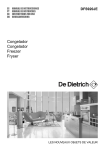Download De Dietrich DTiM1000C
Transcript
CDI>8: USER INSTRUC TIONS I67A: 9: 8J>HHDC ¹AZ E^Vcdº “Le Piano” HOB Dear Customer, You have just purchased a DE DIETRICH hob and we would like to thank you. To offer you an excellent product, our research teams have created this new generation of appliances. Their quality, appearance, functions and technological advances make them exceptional products, showcases of our unique know-how. You will also find a wide range of ovens, ventilation hoods, dishwashers, refrigerators and washing machines, all of which can be coordinated with your new DE DIETRICH hob. Of course, as part of our constant desire to ensure that our products satisfy your needs in the fullest way possible, our customer service department is always at your disposal on our web site. www.de-dietrich.com DE DIETRICH Valued since 1684. With a view to the constant improvement of our products, we reserve the right to make any modifications to their technical, functional or aesthetic characteristics, as a result of technical developments. Important Before installing and using your appliance, please read this guide to its installation and use carefully; it will help you to quickly familiarise yourself with its operation. 2 CONTENTS EN 1 / INSTALLING YOUR APPLIANCE • Building-in __________________________________________________________ • Connection _________________________________________________________ 4 5 2 / USING YOUR APPLIANCE • The induction principle ________________________________________________ • Use of the heating surface _____________________________________________ • Safety in operation ___________________________________________________ 6 6 7 3 / ROUTINE CARE OF YOUR APPLIANCE _____________________________________ 8 4 / SPECIAL INSTRUCTIONS, TROUBLESHOOTING _____________________________ 9 5 / AFTER-SALES SERVICE AND CUSTOMER RELATIONS _______________________ 10 3 EN 1/ INSTALLING YOUR APPLIANCE Above a cabinet with a door or drawer • CHOICE OF LOCATION The distance between the edge of your appliance VENTILATION SPACE and the side and rear walls (or partitions) must be 40mm at least four centimetres (zone A). Your appliance may be built in without any restriction. Check, however, that the air intakes and outlets are free of obstruction. The building-in method opposite is recommended for use above an oven or built-in appliance. The ventilation space is essential in all configurations. MINI 4 mm Above an oven • BUILDING-IN Follow the diagram above. Glue the foam seal underneath the appliance, following the perimeter of the hole in the worktop, upon which the appliance will rest. This will ensure a good seal against the worktop. Tip If your hob is located above an oven, the hob’s thermal safety devices can impede the simultaneous use of the hob and the oven’s pyrolysis program. The hob is equipped with a safety system to prevent overheating. This safety device can be activated, for example, when the hob is installed above an oven that is not sufficiently well insulated. In such circumstances we recommend that you improve the hob’s ventilation by creating an opening in the side of the cabinet, (8 x 5 cm), and/or also installing an oven insulation kit available from our after-sales department (Ref. 75X1652). You can also install your hob above a dishwasher. In that case, your worktop must be at least 900mm high in order to ensure the proper ventilation of your hob and you could also fit the dishwasher insulation kit that is available from the after-sales Service (Ref. 77X7781). 4 EN 1 / INSTALLING YOUR APPLIANCE Connection This hob must be connected to the mains via an accessible socket complying with publication IEC 60083 or an all-pole circuit-breaker device complying with current installation rules. When power is first supplied to your hob, or after an extended power cut, a code will be displayed on the control panel. This information will disappear after 30 seconds. •220-240 V single phase 16 and 32 Amp fuses Brown Live Blue Green/yellow Blue Brown L Neutral Green/yellow 63 Amp fuse. N Blue 16 A Green/yellow Earth Earth L Neutral N Earth Green/yellow Neutral N Brown Live Live 32 A Blue Brown L Black-grey Black-grey •400V 3N three phase Separate the 2 phase wires (L2 and L3) before connection. 16 Amp. fuse. Brown Blue Live Neutral Green/yellow L1 N Earth Green/yellow Blue Brown Live L2 Live L3 Black-grey Warning If the cable is damaged, it must be replaced by the manufacturer, its aftersales department or a similarly qualified person . For a 400 V 3N three-phase connection, in the event of problems using your hob, make sure that the neutral conductor is properly connected. 5 EN 2 / USING YOUR APPLIANCE This cooking hob has been designed for private domestic use. It is intended exclusively for cooking beverages and foodstuffs and does not contain any asbestos-based materials. This appliance is not intended to be used by persons (including children) with physical, sensory or mental disabilities, or those lacking experience or awareness, unless supervised by someone responsible for their safety, or they have received suitable instruction on how to use the appliance. Children should be watched to ensure that they do not play with the appliance. •The induction principle The induction principle is based on a magnetic effect. When you place cookware on a cooking zone and turn the appliance on, the electronic circuits in the hob produce “induced” currents in the bottom of the cookware which instantly raise its temperature. This heat is then transmitted to the food. C B A + - A - Induction plate •Cookware B - Electronic circuit Most cookware is compatible with induction. To verify that your cookware is suitable, place it on a heating zone and touch the screen. - If the display remains on, your cookware is compatible. - If the display flashes, your cookware cannot be used for induction cooking. You can also use a magnet to test the cookware. If it does not stick to the bottom of the cookware, it is not compatible with induction. C - Induced currents •Cooking zone The cooking zone can take up to five pans simultaneously. The heating area adapts automatically to the shape of the pan. Three operating modes are available: Only glass, earthenware, aluminium without a special bottom, copper and some nonmagnetic stainless steels do not work with induction cooking. We recommend that you select cookware with a thick, flat bottom. Solo Mode : The hob provides uniform power across the full surface. Piano Mode : The hob is split into 3 separate zones. You can alter the power of each zone. If a dish straddles two or three zones, the power supplied is averaged. Expert Mode : You choose the power to be applied to each of your saucepans. 6 N.B.: the size of the bottom of the pan must be at least 10 cm in diameter. 2 / USING YOUR APPLIANCE EN As indicated by this logo, the materials used to package this appliance can be recycled. Please recycle the packaging and help protect the environment by depositing it in municipal containers provided for this purpose. The manufacturer will arrange for the appliance to be recycled properly, in accordance with European Directive 2002/96/EC on Waste Electrical and Electronic Equipment. Contact your local authority or retailer for details of collection points for old appliances. Safety in use •“Small Items” safety •Residual heat If you place a small object on the surface (a ring, a fork, etc), the hob will not detect it. After a long period of cooking, the zone used can remain hot for several minutes. A“ ” will be displayed during this period. Do not put your hand on the zone. •Temperature limiter The cooking surface is equipped with a safety sensor that constantly monitors the temperature of the bottom of a pan. If you leave empty cookware on a zone which is turned on, the power will be limited automatically to prevent damage to the cookware or hob. •Protection against spills In the event of spillage, or of a metallic object or wet cloth placed on the touch screen, the hob turns itself off. Clean the screen or remove the object and recommence cooking. N.B.: However, several small objects on the surface at the same time could be identified as cookware. In that case, power will be delivered by the hob. It is recommended that you avoid placing metal objects such as knives, forks, spoons and lids on the cooking surface, as they may heat up. Take care also not to place a lid on the cooking zone when moving a pan. For safety reasons, food should not be fried in a small pan with a bottom of less than 14 cm in diameter. •Auto-Stop system Should you forget that cooking is in progress, this safety function will automatically turn the hob off after a predefined time (between 1 and 8 hours depending on the power setting). Auto Stop” is displayed and a beep sounds “A for about 2 minutes. Press an active button on the touch screen to clear the information. •For users with heart pacemakers and active implants. The hob’s operation conforms to current electromagnetic interference standards and so complies fully with legal requirements (89/336/EEC directives). In order to avoid interference between the hob and a heart pacemaker, the pacemaker must be designed and programmed in compliance with the regulations applying to its use. Since we can only guarantee the compliance of our own products, we strongly recommend that you refer to the manufacturer of your device or to your doctor, to avoid any possible incompatibility. 7 EN 3 / ROUTINE CARE OF YOUR APPLIANCE Look after your appliance The vitroceramic glass surface is very strong, but not unbreakable. Here are some recommendations for increasing its life: - Avoid impacts and friction from cookware. - Avoid putting a hot lid down flat on the hob. A “suction” effect could damage the vitroceramic surface. - Do not use cookware with bottoms that are rough or dented. - Do not use your cooking hob as a work surface. - Never use paper or an aluminium tray for cooking. The aluminium would melt and damage the top. - Never use a steam cleaner to clean your hob. - Never directly heat a tin can. It could explode. - - Do not place a hot pan on the touch screen. Aesthetic faults, resulting from mistreatment of your hob and which do not result in a loss of function, are not covered by the guarantee. And for the safety of your kitchen, do not place cleaning items or inflammable objects/products in the cabinet below your cooking hob. Caring for your appliance TYPES OF STAINS/SPOTS USE WHAT SHOULD I DO? Light. Cleaning sponges Thoroughly moisten the zone to be cleaned with hot water, then wipe off. Accumulation of bakedon stains/dirt. Sugar spills, melted plastic. Cleaning sponges Special scraper for glass. Thoroughly moisten the zone to be cleaned with hot water. Use a special glass scraper to remove large items, then use the coarse side of a household sponge and finally wipe off. Hard water rings and residue. White vinegar. Apply warm white vinegar to the stain, allow to stand, then wipe with a soft cloth. Shiny metallic streaks. Weekly care. Specific products for cleaning vitroceramic glass. Apply a vitroceramic glass cleaning product to the surface (preferably one with silicone for its protective properties). cream special cleaning sponge for delicate crockery. powder 8 abrasive sponge 4 / SPECIAL INSTRUCTIONS, TROUBLESHOOTING EN •On first use YOU NOTICE THAT: Your installation trips or blows a fuse. Only a part of the cooking zone works. The hob gives off an odour on the first few occasions that you use it. POSSIBLE CAUSES: WHAT SHOULD YOU DO? The electrical connection of your hob is defective. Check that it is correctly connected. See the “Electrical Connection” section. New appliance. Nothing. The smell will disappear after a few uses. POSSIBLE CAUSES: WHAT SHOULD YOU DO? •When switching on YOU NOTICE THAT: The hob does not operate and the touch screen does not illuminate. There is no supply to the appliance. The supply or connection is defective. Inspect the electrical circuit breaker and fuses. •While in use YOU NOTICE THAT: POSSIBLE CAUSES: The hob has stopped working. WHAT SHOULD YOU DO? There is water or an object obstructing the touch screen. Clean the hob or remove the object, then begin cooking again. When switching on the cooking The cookware you are using is See section on zone, the cookware display not suitable for induction or is cookware suitable for flashes. less than 10 cm in diameter induction. The saucepans make a noise during cooking. Your hob makes a clicking sound during cooking. This is normal with some types Nothing. There is no risk of cookware. This is caused by to your hob or your the transfer of energy from the cookware. hob to the cookware. The fan continues to function a for few minutes after the hob is turned off. Cooling of the electronic components. Working normally. Nothing. No display on the touch screen but cooking continues. Touch screen not working Remove the cookware in use from the hob and contact after-sales service. Touch screen working. Touch screen not working Remove the cookware in use from the hob and contact after-sales service. buttons not The touch screen displays “Demo mode” The hob mode". suggests 9 "Demo Select “Quit” on the touch screen. EN 5 / AFTER-SALES SERVICE Any maintenance on your equipment should be undertaken by: - either your dealer, - or another qualified mechanic who is an authorized agent for the brand appliances. When making an appointment, state the full reference of your equipment (model, type and serial number). This information appears on the manufacturer's nameplate attached to your equipment. For UK after sales service information please contact:www.dedietrich.co.uk De Dietrich UK office – tel: 01256 308000 In the event of breakage, cracks or even light fissures in the vitroceramic glass, remove the fuses or trip the hob’s circuit breaker, to avoid the risk of electrical shock. Contact the After-Sales Service department. FagorBrandt SAS, tenant-manager – SAS with share capital of 20 000 000 euros RCS Nanterre 440 303 196. 10










